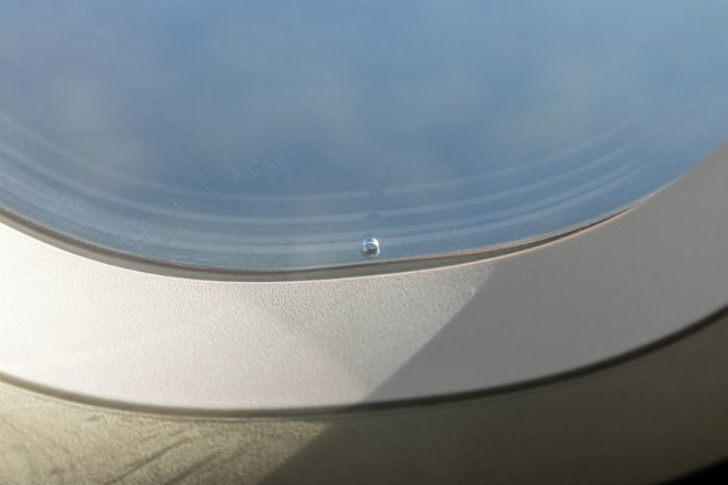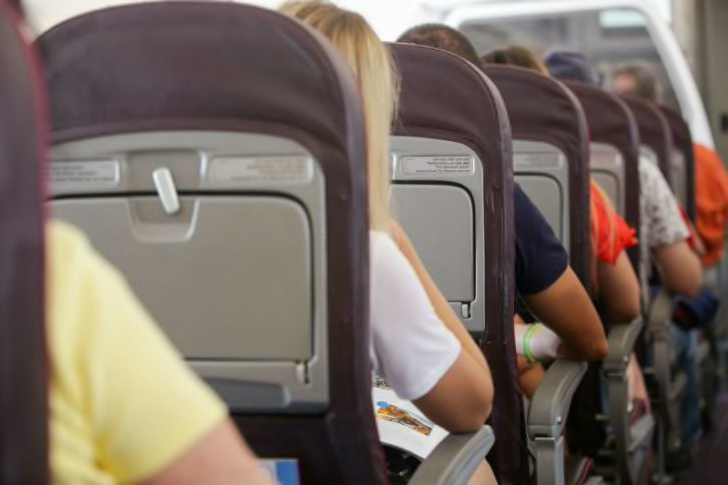Of the many uncomfortable places humans can find themselves, the airplane cabin is among the most common—and puzzling. These high-speed cylinders can cross the globe, but the price is stuffy air, peculiar design choices, and strange amenities. If you've ever found yourself trapped on a long flight, and curious about why the seats are blue or why cabins are so cold, keep reading.
1. Why don't airplane seat belts have shoulder straps?
thawatpong/iStock via Getty Images
We'll get the more obvious question out of the way: Yes, in the highly unlikely event of a serious plane crash, a seat belt is not likely to make a difference in mortality rates. The belts are really in place to keep passengers from being injured during turbulence, which can cause loosely seated travelers to bump their heads on the overhead compartments or walls. (According to the Federal Aviation Administration, there were 234 accidents involving turbulence from 1980 to 2008, with almost 300 serious injuries and three fatalities. Of the latter, two were not wearing seat belts.)
The bigger mystery is why airplane belts aren't more like car seat belts, which might prevent people from bumping their head on the seat in front of them. The reason has to do with the environment. For a shoulder harness to work, the belt would have to be secured either to the cabin wall, which is not as sturdy as a car frame, or the seat. If it was attached to the seat, modifications would have to be made that would increase the plane's overall weight. Planes are also unlikely to experience side collisions, which is where shoulder harnesses would work best.
The belts also have what's called a lift-lever instead of a button release. That's in case an object in the cabin falls and accidentally presses the button.
Those old-school buckles have one additional advantage. They're cheap, saving airlines money—savings they pass on to you, the customer. (Just kidding. They probably don't do that.)
2. Why are airplane bathrooms so small?
VVF/iStock via Getty Images
The phone booth-sized lavatories on planes are actually getting smaller. A popular new model dubbed the 737 Advanced Lavatory being installed in nearly half of all new aircraft increases non-pooping cabin space by 7 inches. The push for shrinking bathrooms isn't actually greed or a need to stuff in more seats. It's a move by airlines to allow for more leg and reclining room—however sparse—for existing seats. And yes, it could be worse. Early aviators pooped in cardboard boxes.
3. Why are airplane cabins so cold?
kasto80/iStock via Getty Images
If you think you've gotten as comfortable as you're likely to get in your seat, you may find a cold front moving in. Following take-off, when air conditioning is turned off to conserve fuel, airplane cabins can become notoriously chilly. Believe it or not, airlines keep it cool for your health. Pressurized cabins combined with warmer temperatures can increase passengers' risk of hypoxia, a condition in which body tissue doesn't get enough oxygen and fainting can result. (Oxygen is decreased at high altitudes, so cabins are pressurized.) Turning down the thermostat can help prevent passengers from passing out. Passengers are also likely to feel colder because they're sedentary and can't warm up by moving around.
4. Why is airplane food so bad?
PJjaruwan/iStock via Getty Images
When you can get better meal options at a gas station, you know something is very wrong with airplane food. The bland concoctions served in cabins are the unfortunate result of preparation, storage, and environmental limitations. Meals are frozen and then thawed in flight. That's because a cabin pressurized to an altitude of 6000 to 8000 feet above sea level (even when the cruising altitude is about 40,000 feet) makes for a less-than-ideal fresh food preparation space.
But isn't serving up a mostly frozen menu what fast food restaurants seem to do well? Maybe, but the difference is that airlines need to serve hundreds of hungry customers at once. To keep lingering meals from drying out, they're often drowning in sauces. Combine that with dry cabin air suppressing our sense of smell and reducing our ability to taste sweet and salty flavors, and you have a recipe for gastronomical disaster.
5. Why is tomato juice so popular on flights?
Cameris/iStock via Getty Images
In addition to water, soda, and more intoxicating options, cans of tomato juice seem to be a surprisingly popular option on flights. That's because the same dry air that affects our sense of smell and makes the food taste off can actually improve tomato juice's flavor. The savory umami of the juice is unaffected by the cabin environment, making the option stand out in an otherwise bland menu.
6. Why are so many airplane seats blue?
roibu/iStock via Getty Images
Not all plane seats are blue, but odds are good you've encountered more than one blue-colored cabin in your travels. Blame sloppy passengers. Unlike bright or dark colors, blue does a good job of hiding stains, blemishes, and other damage, making it a perfect tone for airlines who don't want to replace seats on a regular basis. Psychologically, blue is also soothing to passengers who might have a little travel anxiety.
7. Why do airplane windows have those tiny holes?
Cristiano Babini/iStock via Getty Images
We know why airplane windows are round: Squared-off windows tend to take on too much stress in a pressurized cabin, a fact airlines noted in the 1950s following an investigation into several accidents. The design also incorporates three window panes, which is where that tiny little hole comes in. The first pane on the plane's exterior takes on the structural burden of pressurization. The middle pane is a back-up in case the first pane fails. The third pane closest to the passenger is there to prevent scratches and damage to the middle pane. The hole is in the middle to help regulate the air pressure between the cabin and the outer and middle panes, leaving the full force of the outside pressure to exert itself on the exterior pane only. That way, if the window gives out, you'll still have the middle pane as a back-up. It also wicks out moisture to keep the window free from fogging.
8. Why do some airplane seats have a triangle above them?
Nopphon Pattanasri/iStock via Getty Images
Look around a cabin and you might see a triangle pasted on the wall near a row of seats. No, this is not for members of secret societies. The markers are there to help crew members identify windows where the plane's wings are the most visible in the event they need to inspect them for damage, ice, or other concerns.
9. What do those chimes over the airplane's intercom really mean?
triocean/iStock via Getty Images
Ding. Ding. At times being in an airplane can feel like being in an elevator. While some of those chimes are meant to call your attention to seat belt alerts or landing notifications, not all of them are intended for passengers. Airplanes use a kind of code similar to a ring tone to call from one section of the cabin to another—to ask about food supplies, for example. Different chimes can mean different things. A three-note chime might tell flight attendants that turbulence is ahead, alerting them ahead of passengers. The code varies by plane, so try not to read too much into it. If you hear just one note, though, it might be the pilot asking for some coffee.
10. Why do your ears pop during a flight?
Kritchanut/iStock via Getty Images
It goes back to cabin pressure. As a plane ascends, lowering the pressure in the cabin, pressure in the inner ear changes. Force is applied to the eardrum and you'll feel like something is squeezing your head until the Eustachian tubes connecting your ears to your nose and throat relax, letting air in and equalizing the pressure.
11. Why don't airplane oxygen mask bags inflate?
Thinkstock/iStock via Getty Images
The vaunted airplane oxygen mask demonstration always causes some concern over its rather inert plastic bag, which attendants often warn "may not inflate" once the masks descend over the passengers in the event of an emergency. If it doesn't inflate, what good is it? The masks are continuous-flow, which means oxygen produced by chemicals in the overhead compartment will flow through the mask regardless of the person inhaling or exhaling. Excess oxygen is stored in the bag until it's needed. It also prevents panicky passengers from seeing their bags "deflate" while others appear full.
No comments:
Post a Comment